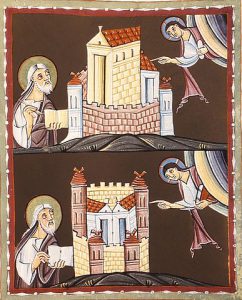 In Revelation 3:9, Jesus promises that a time will come when the Jews who are persecuting them will bow at their feet. He says, “Behold, I will cause those from the synagogue of Satan, who are calling themselves Jews and they are not but are lying, behold I will cause them to come and bow down at your feet and come to know that I have loved you” (3:9). The reference to the “synagogue of Satan” provides an important link to the Smyrna letter (2:9). Jesus’ promise here is quite ironic if interpreters are correct in seeing an allusion to Isaiah 60:14. In Isaiah 60:14, the Lord promises Zion that a time will come when the sons of her Gentile oppressors will come and bow down at her feet and acknowledge that she is the city of the Lord (see quotation below). Similarly, in Revelation 3:9, Jesus promises that the oppressors of his church will “come and bow down at your feet.” In effect, then, Jesus is making a promise to his church that the Jews of Philadelphia would regard as backwards based upon Isaiah 60:14, since they appear to regard the church as unbelieving Gentiles. The implication of Jesus’ promise is that he regards his people as the true people of God who will experience the fulfillment of God’s promise to Zion. The “synagogue of Satan” has turned away from God and become oppressors of the people of God. They will bow down before the people of the Lamb, which includes both Jews and Gentiles. Jesus’ promise is probably a promise related to the end times, like his promises to the conquerors (3:12). Here is what Isaiah 60:14 says, “The sons of those who afflicted you will come bowing to you, and all those who despised you will bow themselves at the soles of your feet; and they will call you the city of the Lord, the Zion of the Holy One of Israel.” (NASB).
In Revelation 3:9, Jesus promises that a time will come when the Jews who are persecuting them will bow at their feet. He says, “Behold, I will cause those from the synagogue of Satan, who are calling themselves Jews and they are not but are lying, behold I will cause them to come and bow down at your feet and come to know that I have loved you” (3:9). The reference to the “synagogue of Satan” provides an important link to the Smyrna letter (2:9). Jesus’ promise here is quite ironic if interpreters are correct in seeing an allusion to Isaiah 60:14. In Isaiah 60:14, the Lord promises Zion that a time will come when the sons of her Gentile oppressors will come and bow down at her feet and acknowledge that she is the city of the Lord (see quotation below). Similarly, in Revelation 3:9, Jesus promises that the oppressors of his church will “come and bow down at your feet.” In effect, then, Jesus is making a promise to his church that the Jews of Philadelphia would regard as backwards based upon Isaiah 60:14, since they appear to regard the church as unbelieving Gentiles. The implication of Jesus’ promise is that he regards his people as the true people of God who will experience the fulfillment of God’s promise to Zion. The “synagogue of Satan” has turned away from God and become oppressors of the people of God. They will bow down before the people of the Lamb, which includes both Jews and Gentiles. Jesus’ promise is probably a promise related to the end times, like his promises to the conquerors (3:12). Here is what Isaiah 60:14 says, “The sons of those who afflicted you will come bowing to you, and all those who despised you will bow themselves at the soles of your feet; and they will call you the city of the Lord, the Zion of the Holy One of Israel.” (NASB).
Sources:
These paragraphs are slightly edited portions of my book:
Paul Hoskins, The Book of Revelation: A Theological and Exegetical Commentary, p. 110 (that page provides further sources and footnotes that I have omitted above).
